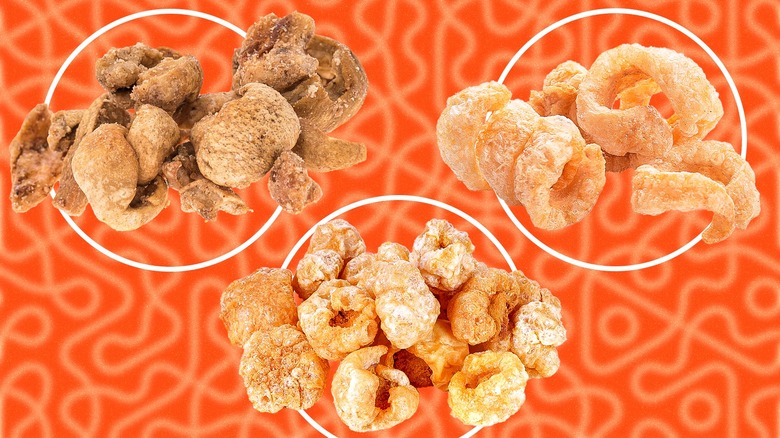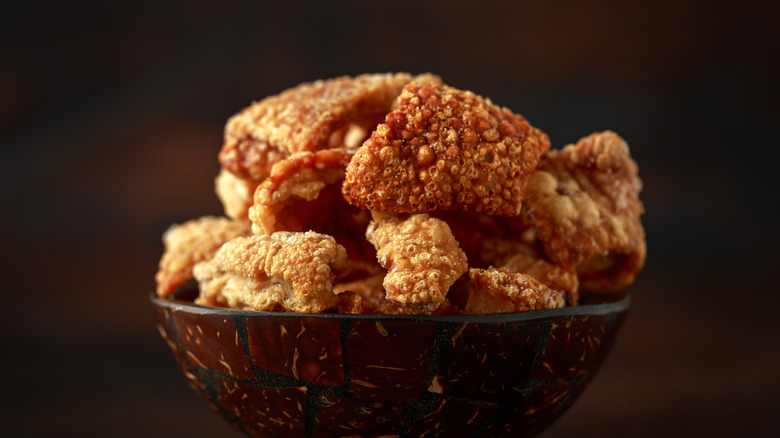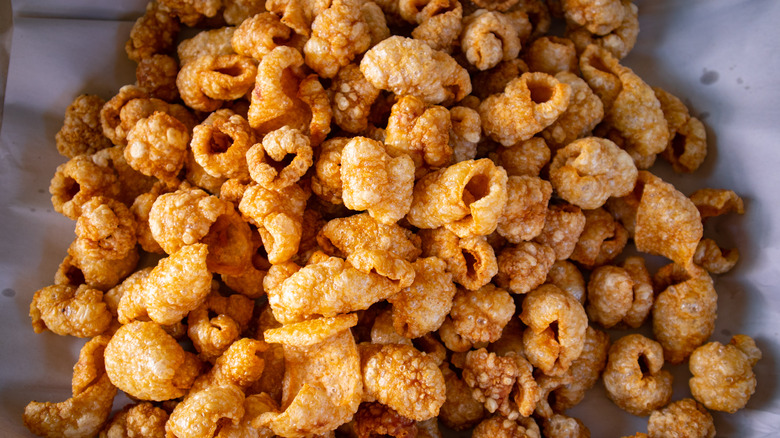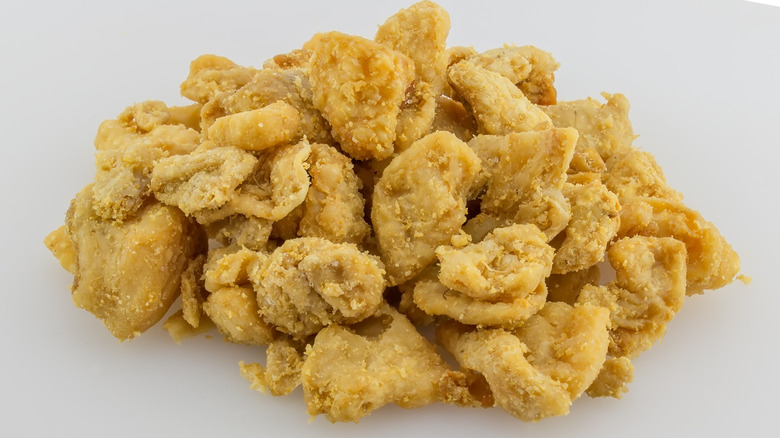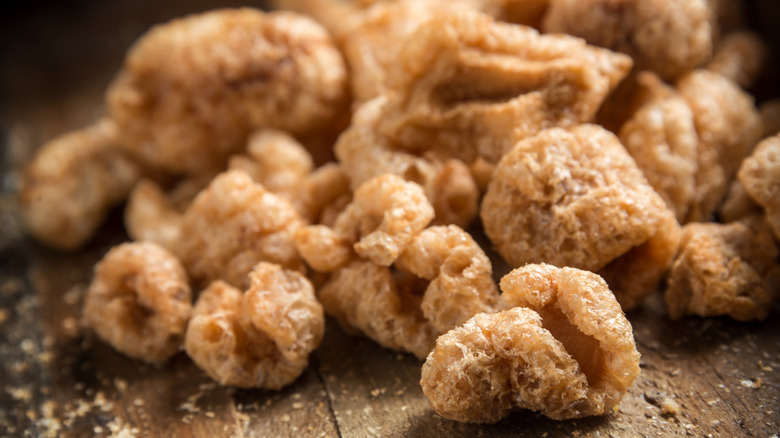How Pork Scratchings Differ From Rinds And Cracklins
Crispy, fried pork skin is more than just your favorite gas station snack. Pork rinds make for an elevated chips and dip experience, and if you crush up fried pork skins, you can turn them into a keto-friendly bread crumb. This road trip staple is a resourceful use of all parts of the pig and comes in various flavors ranging from barbecue to Nashville hot. The snack makes appearances all over the globe: in Spain and Central America, they're called chicharrones and are often served with lime and hot sauce (we ranked the best chicharrones brands if you're looking for recommendations).
Pork rinds, pork scratchings, and pork cracklins are all similar in that they're variations of fried pork skin, but don't be fooled! Each of these iconic snacks has its unique means of preparation. While the flavor and textural differences between the products might be minimal to the untrained eye, knowing the distinctions allows you to choose the most delicious snack for your preferences.
What are pork scratchings?
Pork scratchings are a popular British pub snack often found in bowls at the bar (here's why salty snacks are offered alongside alcohol). The skin for scratchings comes from the shank, which is the upper portion of the pig's hind leg. Of the various pig skin snacks, scratchings are the most deeply pork flavored. This intense, meaty flavor is thanks to the many layers of fat fried with the skin. Because of its natural flavoring, scratchings usually don't need additional seasoning or flavoring.
Scratchings originated in the 1800s when working-class families in the United Kingdom would create them to make the most of their meat. Pork scratchings are harder and crunchier when compared to other pork snacks, and they're less airy than rinds. The density of pork scratchings makes them a heftier snack that is almost comparable to the snap and toughness of a pistachio or almond.
What are pork rinds?
Pork rinds are probably the most familiar option if you're American. These crispy and puffy versions of fried pork skin are almost translucent in some spots because of aeration. Rinds only use the skin of the pig — unlike similar snacks that fry fat with the skin.
Making pork rinds is a multi-step process: The pig skin is boiled and then frozen to make it easier to remove the fat. Before frying the skin, it is baked at a low temperature for several hours to remove moisture, similar to how you might dehydrate beef jerky. Removing the moisture causes the rinds to puff up and get their signature texture. It's much more common to see pork rinds come in different flavors than scratchings since the skin itself does not contain a ton of flavor. Seasoning is added right after the rinds come out of the fryer so that the flavor adheres all over.
What are pork cracklins?
Cracklins originated from Cajun cuisine and are often sourced from the pig shoulder. They have a small strip of fat attached to the skin, bringing back some of that natural pork flavor. When pork fat is rendered, pieces of skin rise to the top, and these bits are then twice fried for a crispy texture that's slightly more dense than rinds. The double frying method for cracklins results in a partial loss of this pork flavor, so you might find cracklins seasoned with salt or other yummy flavors like a Cajun seasoning blend.
Cracklins are more commonly found in the South rather than worldwide like other pork snacks but they retain the same origins of being a resourceful way to use all parts of the pig. Though incredibly similar, pork rinds and cracklins do differ slightly. Cracklins have a puffed appearance that is similar to rinds but with a more solid crunch like scratchings, making them a unique snack option that rests between the other two.
Pork scratchings are hard and crunchy
The texture is the biggest difference between the crispy snacks. You might want to be cautious when biting into a pork scratching. They are tough and require a strong bite to break down. This intense texture comes from the fact that scratchings are fried once. The density makes scratchings a more filling snack, which is perhaps a reason why they're commonly found as a pub snack in the U.K.
In comparison, rinds and cracklins have an almost bubbly texture to them. The pockets of the air come as a result of the double frying and low-fat content of the pig skin. This makes the rinds and cracklins a little easier on your teeth, but they don't have quite the same stomach-filling effect as scratchings. Depending on how fresh your rinds or cracklins are, they can have a melt-in-your-mouth effect, making for a fun-to-eat treat.
Pork Scratchings are meaty tasting
If you're looking for a pork snack with a strong pork flavor, then scratchings are going to be your best option. The higher fat content gives them a deep savory, umami, meaty flavor that's perfectly addictive on its own. You won't find scratchings heavily seasoned beyond some salt. The natural flavor is where they shine. They almost have a natural flavor similar to bacon, with a salty, buttery taste.
There are several flavor options available for pork rinds and cracklins. The light texture and minimal fat content make these piggy puffs the perfect vehicle for taking on almost any flavor you can imagine. Common flavorings include southern-inspired seasonings such as Cajun, mesquite BBQ, or plain old salt. But, there are also some more unique options, like dill pickle and queso. You can even dress them up with dips and sauces if you so desire. The option to have this multitude of flavors makes them more chip-like than the scratchings.
